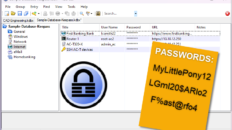I’ve been reading, listening and collecting my thoughts on Juniper’s latest addition to their happy hardware family and I’ve reached a few conclusions. I’d have to give it all a B+… for Blown, way out of proportion (that’s the + part).
Sorry to put it so bluntly- I love Juniper products, technology and their people, but I have to call this one out. Alan had me chuckling on his extremely short response to the news and I found myself agreeing whole-heartedly with the words of Mike Fratto. And yes, I did love Robert’s sweet little write up in CRN- warm and fuzzy even if a bit over-ambitious- I’ll stick with my tea, thank you.
We weren’t sure what exactly was coming, so when the big unveiling revealed two series of fixed-form stackables I was left with a slightly empty feeling inside. I’ll be honest- I expected something more. So I did some checking on the ‘selling points’ hoping to find some hidden Magic Network Sauce along the way.
I was disappointed when I examined several of the ‘features’. They’re pitching the stackables as a more flexible and cost-effective alternative to chassis-based switches. One document title promises “true chassis functionality” but the true flexibility of a chassis is the option for a variety of modules, whether they be access ports, wireless management modules, security modules, etc. That’s something you can’t possibly get in a fixed-form switch- sorry.
To add insult to injury, part of the chassis-replacement pitch is for lower power consumption. So imagine my surprise when I started adding up the numbers- looks like a fully-populated 6-slot chassis from ProCurve could power 144 PoE ports for just a little more juice than Juniper’s 48-port EX flavours.
The Security feature list is a bit over-hyped as well. I see 7 bullet items for 802.1X features that have much less to do with the switch, and much more to do with the IEEE standard and the implementation method. And what I don’t see is the option to do Web-Auth and Mac-Auth as supplements to 1X.
If you examine the Layer 2 features, you’ll see similar repetition- 6 of those items are all various ways of describing spanning tree features, several encompassing the others. And they give you a ‘Voice VLAN’ as part of the Layer 2 features too- very nice of them. It might not be all bad, were not for the pricey sticker- starting at
I’ve been reading, listening and collecting my thoughts on Juniper’s latest addition to their happy hardware family and I’ve reached a few conclusions. I’d have to give it all a B+… for Blown, way out of proportion (that’s the + part).
Sorry to put it so bluntly- I love Juniper products, technology and their people, but I have to call this one out. Alan had me chuckling on his extremely short response to the news and I too found myself agreeing whole-heartedly with the words of Mike Fratto. And yes, I did love Robert’s sweet little write up in CRN– warm and fuzzy even if a bit over-ambitious- I’ll stick with my tea, thank you.
We weren’t sure what exactly was coming, so when the big unveiling revealed two series of fixed-form stackables I was left with a slightly empty feeling inside. I’ll be honest- I expected something more. So I did some checking on the ‘selling points’ hoping to find some hidden Magic Network Sauce along the way.
I was disappointed when I examined several of the ‘features’. They’re pitching the stackables as a more flexible and cost-effective alternative to chassis-based switches. One document title promises “true chassis functionality” but the true flexibility of a chassis is the option for a variety of modules, whether they be access ports, wireless management modules, security modules, etc. That’s something you can’t possibly get in a fixed-form switch- sorry.
To add insult to injury, part of the chassis-replacement pitch is for lower power consumption. So imagine my surprise when I started adding up the numbers- maybe I need to redo my math, but it looks like a fully-populated chassis from ProCurve could power all its PoE ports for just a little more juice than Juniper’s 48-port EX flavours.
The Security feature list is a bit over-hyped as well. I see 7 bullet items for 802.1X features that have much less to do with the switch, and much more to do with the IEEE standard and the implementation method. And what I don’t see is the option to do Web-Auth and Mac-Auth as supplements to 1X.
If you examine the Layer 2 features, you’ll see similar repetition- 6 of those items are all various ways of describing spanning tree features, several encompassing the others. And they give you a ‘Voice VLAN’ as part of the Layer 2 features too- very nice of them. It might not be all bad, were not for the pricey sticker- starting at $4,000 for a 24-port stackable, with partial PoE support. (And why on earth would you make a switch with partial PoE anyway?)
Most of the ‘cool’ features are already available in most other vendors’ solutions- either hardware or software- so you can relax- there’s no Ethernet Fairy Dust hap’nin here. Your current switches are probably fulfilling everything you think you’re missing from the precocious EX feature list.
I could go on, but why bother. It seems whomever wrote the features and spec sheets isn’t too familiar with basic switching technology, standards and protocols. That will come in time I suppose.
Do I think the switches will fail in the market? No. If for no other reason than Juniper is a good company with good products, good technology and happy customers. An EX might not make your morning waffles, but it’s definitely a viable solution for all those seeking ABC (Anybody But Cisco) and that’s how I’d position it.
So, I’m not drinking the Kool-Aid quite yet. I think they’re a little green in the switch technologies and they’ll need to ride on their reputation to kindle the fire. But for now, Juniper is our little darling, and the EX switches are the masterpieces of our aspiring artists- proudly hung on the refrigerator door… not ready for that NY Gallery, but showing some definite potential.
# # #








